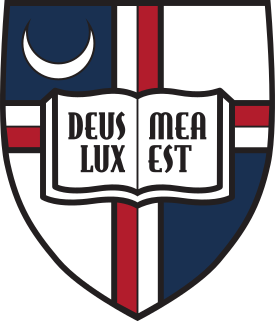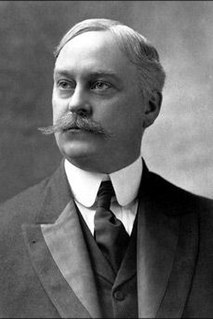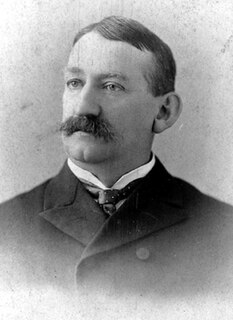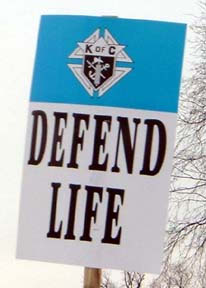Early years
Both the university and the order were founded in the 1880s, and they have been closely aligned ever since. By 1920, Pope Benedict XV praised the Knights for the commitment to the faith, and singled out their contributions to the University as an example of it. [5]
Keane Council
On June 5, 1898, Keane Council 353 was established at the university, though in later years it moved off campus. [1] It was instituted with 66 charter members, and Lawrence O. Murray, Comptroller of the Currency, as Grand Knight. It "formed its nucleus in the Catholic University", in the words of Philip Garrigan, one of Keane's founders and vice-rector of the university. [6] It was named for Irish-born Bishop John J. Keane, first rector of the University (1889–1896), and later Archbishop of Dubuque, Iowa. First meetings were in the Typographical Temple, then move to Grand Army Hall on October 12, 1898, then to the Maccabee Temple the following June.
Chair of American History

On March 7, 1899 Vice Rector and Knight Phillip Garrigan addressed the National Council, as the Supreme Convention was called at the time, asking for establishment of a Knights of Columbus Chair of American History at the University, to counter the somewhat anti-Catholic bias of history-writing at the time. [1] [6] He said that "we are attacked by anti-Catholic spokesmen on every side, partly because we have no historian among us." [6] He added that while Protestant historians "do not mean to be unfair... they cannot take Catholic facts and analyze them and give them the mainspring of the action and estimate fairly the character of the men." [7]
Garrison told the assembled convention that his vision was for the historian who took the chair to be of such high stature that "the defamer of Catholic truth will be silenced" in his presence. [8] He also mentioned to the Knights, the vast majority of whom were either born in Ireland or were of Irish descent, that the Ancient Order of Hibernians had recently donated $50,000 to establish a chair in Celtic Language and Literature. [8]
The convention enthusiastically accepted the proposal. By March 5, 1901, Supreme Knight Edward L. Hearn reported unhappily to the national convention that only $10,000 has been collected of the $50,000 commitment made two years earlier. [9] It would take an additional three years to collect the total amount. [9]
Over 10,000 Knights were on hand on April 13, 1904 to present a $55,633.79 check ($1,399,831.80 in 2012 dollars [10] ) to endow the Knights of Columbus Chair of American History to Cardinal James Gibbons, Chancellor of the University and a strong supporter of the Knights. [9] [11] The outdoor ceremony was held on the steps of the University's McMahon Hall. [1] The gigantic check was ten feet high and four feet wide, and was beautifully executed on vellum in the style of an illuminated manuscript. [1] [9] It was later hang in the dining hall of the University Center West through the end of the century, and then in the newly renovated McGivney Hall after that.
Supreme Knight Hearn, who viewed the Order as a sort of Catholic anti-defamation league, said at the presentation that "non-Catholic historians... find no room in their histories to laud the magnificent work done in the early days of the nation by the Catholic missionaries and Catholic pioneers... These are the evils we seek to remedy by founding this Chair of American History." [12]
The check represented "the Order's first response to a call from the American Church," which demonstrated to any doubters, and the early Knights did encounter opposition within the Church, that the Order was thoroughly Catholic. [9] A number of bishops were on hand for the presentation as well, which was the first time the American hierarchy gave such an ovation to the Order. [9] The establishment of the Knights of Columbus Chair inaugurated the department of history of the University, but it was another five years before the new history program added other fields, with undergraduate courses in "general history" in 1909, and medieval history in 1914.
The first occupant of the chair was Dr. Charles Hallan McCarthy. [13] [14] McCarthy, who studied at the University of Pennsylvania, was teaching in a high school and was not a Knight, and thus was a controversial selection. [14] Some thought the position should go to John H. Ewing, a professor at the University of Notre Dame and the first state deputy of Indiana. [15] McCarthy performed admiralty in the position however, and directed several graduate students who went on to great things, including Matthew J. Walsh. [14]
Scholarships
In December 1904, Cardinal Gibbons appealed to the Knights for more financial aid to help meet operating costs after some investments went sour, and the Order gave nearly $25,000. [11] [15] In his letter, he referred to the Knights' "princely munificence" and added that "I know that your bounty is limited only by your means." [15]
By 1907 the financial situation of Catholic University had improved but was still shaky. [16] Archbishop John J. Glennon of St. Louis, chairman of a committee to plan for a $500,000 endowment, appealed to the Knights as the committee believed the Order was the only organization which could raise such a large sum. [17] On August 8th he addressed the national convention in Norfolk, urging the Order to "fuse the activities of your Society into one grand movement that would stand out at the head of all Catholic National and Charitable movements in the United States." [17] He added that doing so would "give you the position your friends believe you are entitled to, namely the leading Catholic Society of the leading Catholic people of the United States." [17]
Hearn did not endorse the proposal, and by at least one account seemed cool to the idea, but left it to the "serious and careful thoughts of the delegates." [17] The National Council accepted the idea in principal, although several proposals to raise the funds could not find enough support to pass. [18] Eventually, Hearn was instructed to appoint a committee to settle the matter. [17]
After some delay, a committee was assembled in January 1908 and finally in December devised a plan that won the support of the Board of Directors in April 1909. [19] Every Knight was mailed a letter and was asked to voluntarily contribute $1 a year for a five-year period. [3] On December 6, 1913 the goal was realized. [1] [3]
At Cardinal Gibbons's residence in Baltimore on January 6, 1914, a party headed by new Supreme Knight James A. Flaherty presented $500,000 in securities, the results of the fund drive for Catholic University. [3] [11] The University and the Order agreed that rather than an endowment as originally planned, the funds would be used to establish fellowships for M.A. or Ph.D. studies with the hope of producing teachers for both Catholic and secular colleges and universities. [3] Originally there was to be one fellowship for every $10,000, with preference going to Knights or their families. [3]
By 1922, 146 K. of C. Fellowships had been awarded. [20] In later years the funds permitted far fewer fellowships, which, in the words of the University's centennial history in 1990 "have remained the most attractive fellowships under the control of the university despite drastic reductions in their number due to the effects of inflation upon university charges for tuition, board, and room." [21]
The fellowships established by the Order, and the active interest shown by some members of the faculty in the Knights, made the University a good place to look for members. In February 1925, Washington Council arranged for a smoker at the University for faculty and students. As a result, a Knights of Columbus Club was organized which in turn resulted in the initiation of about fifty students into the Council annually during the next few years. Some became officers.
Sun Bowl
After the 1940 Sun Bowl, Knights of Columbus in El Paso took the Cardinal football players over the border for lunch [22] in the "squalid but colorful Mexican town" of Ciudad Juárez. [23]









